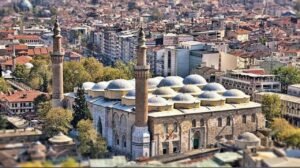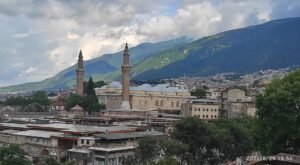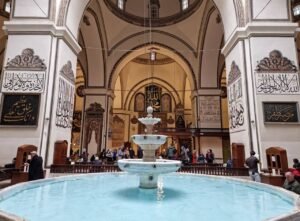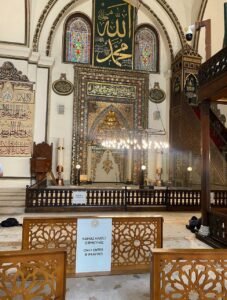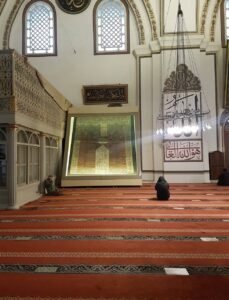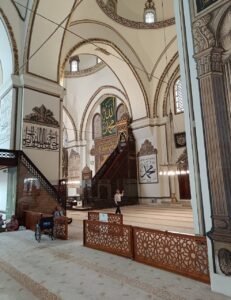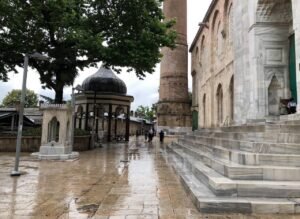Description
Discovering the Majestic Grand Mosque (Ulu Camii) of Bursa: A Journey into Ottoman Elegance
Nestled in the heart of the historic city of Bursa, Turkey, the Grand Mosque—locally known as Ulu Camii—stands as a testament to the grandeur of early Ottoman architecture and Islamic artistry. As one of Turkey’s most significant religious and cultural landmarks, this mosque draws visitors from all over the world with its spiritual atmosphere, architectural brilliance, and deep-rooted history.
A Glimpse into History
The Grand Mosque of Bursa was commissioned by Sultan Bayezid I and built between 1396 and 1399. This monumental structure was erected following the sultan’s victory at the Battle of Nicopolis, and it was part of his vow to construct twenty mosques in honor of his triumph. Instead, he opted to build one grand mosque with twenty domes—symbolically fulfilling his pledge.
Designed by the architect Ali Neccar, the Ulu Camii reflects the transitional period of Ottoman architecture when influences from the Seljuk era were blending with new Ottoman styles. As the largest mosque in Bursa and one of the largest in Turkey, it served not only as a place of worship but also as a central point for education, gatherings, and social affairs.
Architectural Highlights
One of the most captivating aspects of the Grand Mosque is its unique layout. Unlike the more centralized dome structures seen in later Ottoman mosques, Ulu Camii features a rectangular plan with twenty small domes supported by twelve massive columns. This grid-like interior creates a feeling of openness and light, accommodating thousands of worshippers at a time.
The exterior of the mosque is understated yet impressive, constructed with smooth stone and adorned with calligraphy and subtle geometric details. The twin minarets—visible from various points in the city—flank the entrance and call worshippers to prayer five times a day.
Once inside, visitors are greeted by the mosque’s most striking feature: a serene indoor fountain, known as the şadırvan, situated directly beneath one of the domes. Traditionally used for ablution (ritual cleansing), this fountain is unique for being placed within the prayer hall—a feature rarely seen in mosque design. The sound of gently trickling water adds to the mosque’s peaceful atmosphere, providing a moment of tranquility amidst the bustling city.
A Masterpiece of Islamic Calligraphy
Ulu Camii is often referred to as an open-air museum of Islamic calligraphy. Over 190 calligraphic inscriptions, created by some of the most renowned artists of the Ottoman era, decorate the walls, columns, and domes. These inscriptions include verses from the Quran, religious sayings, and the names of Allah and the Prophet Muhammad (PBUH), each rendered in elegant and diverse script styles.
Particularly impressive are the giant medallions, some over two meters wide, painted directly onto the walls. These works of art are not only religious symbols but also exemplify the rich heritage of Ottoman calligraphy, making the mosque a treasure trove for art historians and spiritual seekers alike.
Spiritual and Cultural Significance
Beyond its architectural and artistic beauty, the Grand Mosque of Bursa remains an active center of worship and community life. It serves as a gathering place for daily prayers, Friday congregations, and special religious occasions such as Ramadan and Eid.
The mosque's central location in the bustling city center of Bursa makes it accessible to both locals and tourists. Nearby attractions such as the Koza Han (Silk Market), Bursa Grand Bazaar, and Orhan Gazi Tomb make the area a vibrant blend of commerce, history, and spirituality.
Ulu Camii and Bursa: A UNESCO Heritage Site
In 2014, the historic center of Bursa and the nearby village of Cumalıkızık were inscribed on the UNESCO World Heritage List, recognizing their significance as the birthplace of the Ottoman Empire. The Grand Mosque is a key element of this heritage zone, representing the spiritual and political emergence of a dynasty that would later rule much of Southeast Europe, Western Asia, and North Africa.
Visiting Ulu Camii offers more than just an architectural journey—it provides a glimpse into the early soul of an empire that would go on to shape the world.
Tips for Visitors
If you're planning to visit the Grand Mosque, here are a few practical tips to enhance your experience:
-
Dress Modestly: As it is an active place of worship, visitors are expected to dress respectfully. Women may be asked to cover their heads, and both men and women should avoid wearing shorts or sleeveless tops.
-
Timing: Try to avoid prayer times, especially the noon and Friday prayers, to explore the mosque without disrupting worshippers.
-
Guided Tours: Many local guides offer historical walking tours that include Ulu Camii along with other nearby Ottoman landmarks.
-
Photography: While photography is allowed, it’s courteous to avoid flash and not take photos during prayers.
A Must-See Destination in Turkey
Whether you are a history enthusiast, an architecture lover, or a spiritual traveler, the Grand Mosque of Bursa offers an unforgettable experience. Its harmonious blend of art, devotion, and architectural brilliance captures the essence of early Ottoman culture.
As you stand beneath its twenty domes, listening to the echoes of prayers or the soft murmur of the fountain, you’ll feel connected to centuries of history and faith. The Ulu Camii is not just a mosque—it is a living monument to a bygone era that continues to inspire all who pass through its doors.
Location
-
Nalbantoğlu, Ulucami Cd. No:2, 16010 Osmangazi̇/Bursa

